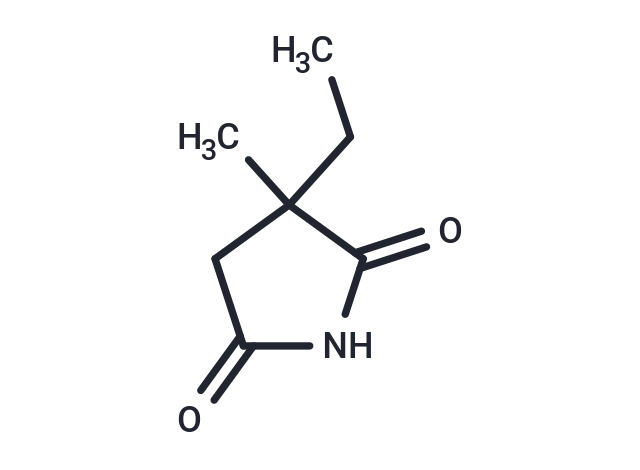Shopping Cart
- Remove All
 Your shopping cart is currently empty
Your shopping cart is currently empty

Ethosuximide (Zarontin) is an anticonvulsant, blocks the low voltage-activated T-type calcium channel used in the treatment of absence seizures unaccompanied by other types of seizures.

| Pack Size | Price | Availability | Quantity |
|---|---|---|---|
| 200 mg | $35 | In Stock | |
| 500 mg | $53 | In Stock | |
| 1 mL x 10 mM (in DMSO) | $57 | In Stock |
| Description | Ethosuximide (Zarontin) is an anticonvulsant, blocks the low voltage-activated T-type calcium channel used in the treatment of absence seizures unaccompanied by other types of seizures. |
| In vitro | Ethosuximide(ETH) enhances hippocampal derived NSC proliferation and neurospheres formation in vitro. Low concentration of ETH induces proliferation of NSC, while higher concentrations of ETH are cytotoxic. Also, ETH activates the PI3K/Akt signal transduction pathway in adult hippocampal NSC in vitro. Blockade of the PI3K/Akt pathway inhibits ETH induced hippocampal NSC neuronal differentiation[3]. |
| In vivo | Anti-epileptic drug ethosuximide rescues the short lifespan and chemosensory defects exhibited by C. elegans null mutants of dnj-14, the worm orthologue of the DNAJC5 gene mutated in autosomal-dominant adult-onset neuronal ceroid lipofuscinosis. It also ameliorates the locomotion impairment and short lifespan of worms expressing a human Tau mutant that causes frontotemporal dementia[1]. Ethosuximide extends lifespan by inhibiting the function of specific chemosensory neurons[2]. It increases neurogenesis, reduces neurodegeneration, and reverses cognitive impairments in rat model of AD like phenotypes[3]. |
| Cell Research | Mouse Neuro2A (N2A) neuroblastoma cells are cultured on 6-well plates and treated with retinoic acid to induce neuronal differentiation. After 24 h, N2A cells are treated with vehicle control (PBS) or increasing concentrations of ethosuximide for 5 h. Total RNA is then isolated, DNase-treated and reverse transcribed to cDNA. qRT-PCR is run above normalising to the reference genes glyceraldehyde-3-phosphate dehydrogenase (GAPDH) and β-actin (ACTB). (Only for Reference) |
| Alias | Zarontin |
| Molecular Weight | 141.17 |
| Formula | C7H11NO2 |
| Cas No. | 77-67-8 |
| Storage | Powder: -20°C for 3 years | In solvent: -80°C for 1 year | Shipping with blue ice. | |||||||||||||||||||||||||||||||||||
| Solubility Information | H2O: 198.3 mM DMSO: 50 mg/mL (354.18 mM) | |||||||||||||||||||||||||||||||||||
Solution Preparation Table | ||||||||||||||||||||||||||||||||||||
H2O/DMSO
| ||||||||||||||||||||||||||||||||||||

Copyright © 2015-2024 TargetMol Chemicals Inc. All Rights Reserved.